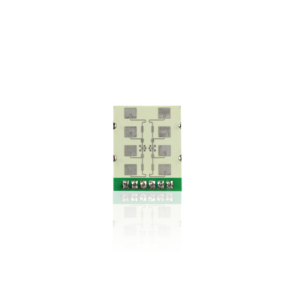Detect motion without distractions
Use distance information to optimise near-range detection
In their efforts to protect buildings from burglars or vandals, owners are increasingly relying on deterrent security measures. And it’s an excellent choice, because alarm systems and related equipment effectively deter potential wrongdoers in the immediate vicinity. The risk of unintentionally drawing attention to themselves and their bad intentions is too great when there’s security equipment in place.
Even simple security solutions, such as a motion-controlled, near-range light system, can make some burglars stop in their tracks and flee – because when it suddenly lights up bright, that might attract the attention of a curious neighbour.
More and more homes and company buildings are thus being equipped with security equipment. In addition to mechanical devices or cameras, owners are equipping the surrounding buildings with sensor devices. These detect movements and usually monitor a small area, i.e. the events around them and in direct proximity of the building being protected.
Another reason why more and more people are securing their homes, company premises, or local shops is the wider selection in the low-cost segment. As technology advances, products have become more affordable over time – and the security market is growing rapidly. Now, companies and private customers have a suitable technological solution suitable for their needs and for any application.
But cheap doesn’t always mean good. Technology also needs to evolve. Because standards are on the rise as security solutions are becoming ever more present and available and property owners are becoming increasingly aware of their advantages and capabilities. They expect maximum security and functionality on a small budget. And particularly when it comes to near-range detection, the equipment’s reliability is very important. Because burglars are already in direct proximity of the object being protected – if the equipment were to fail to detect the intruder or stop working, it could no longer prevent a break-in.
False alarms triggered by irrelevant events (e.g. animals, passers-by) cannot be tolerated either. They prove nerve-racking or even costly if a security service is alerted.
No further developments in sight any time soon.
Due to its appealing price, passive infrared technology dominates the motion detection sector. But it often reaches its limits, especially when used outdoors, as this particular measurement technology struggles with weather and lighting conditions. Cheap products might be triggered to switch on the light by wind movements, for instance. Heat-insulating clothing can also inhibit the detection of people. Further development of this technology seems to be stagnating – in part because these challenges are difficult to resolve due to the inherent properties of the measuring method.
Alternative to PIR
Radar technology is promising. However, it still has to contend with negative presumptions from the past, as radar has long been considered too expensive for such simple use cases. This assumption had its reasons – the technology offers more functions and was therefore often being used for much more complex applications, such as driver assistance systems. But with technological progress, developers have managed to achieve ever-cheaper prices. Today, radar-based motion detectors thus boast more functions and are taking the low-cost range by storm.
The perfect choice for security equipment.
The use of radar technology for near-range surveillance solves numerous problems. The sensors’ functionality cannot be impacted by weather or lighting conditions. Not even extreme temperatures or dirt inhibit detection. Radar also not only detects the presence and movement of people, but also provides further information about objects, such as their speed or direction of movement. Using this additional data, various functions can be implemented that optimise the technology’s performance. One such example is filters that hide small animals based on their radar cross-section value.
Distance measurement – a clear advantage.
Radar boasts an important feature for security technology: distance measurement. For one thing, the distance between the sensor and people can be determined in order to be better assess the situation’s risk. (The closer the target is to the property being protected, the faster the response time required to prevent damage.) This feature is especially available and useful with long-range radar sensors.
For another thing, the detection results can be filtered by distance. The range of action of the surveillance system can thus be better adapted to the individual location. For example, adjacent properties and roads can easily be hidden. The radar ignores passers-by on the pavement or regular motions caused by passing vehicles outside the defined range of coverage. The user filters out potential interfering factors and distractions based on the distance information. This results in a significantly reduced false alarm rate.
Motion detector 2.0
InnoSenT has been developing sensors for motion detection since it was founded in 1999. Initially, they were mostly used as door openers. But soon, the developers drew on knowledge from other industries to take their motion detection products to the next level. They established crucial features, such as distance measurement, and thus offer customers extended functionality at a low price. The further development in terms of functionality enables needs-based control. This makes motion detection appealing for many new applications. Such sensor solutions are a real alternative to infrared or conventional CW radars, especially when used outdoors and for security.
In the security sector, distance measurement proves particularly beneficial in the following applications:
The functions of InnoSenT’s radar products are ideally suited for the various applications. They usually have additional features that boost performance. One good example of this is the new IMD-2000 – a motion detector with distance measurement for the low-cost segment. The sensor also provides filtering of the detection results via the RCS value and an anti-blocking function.
Header Picture Source: © Studio Harmony by adobe stock
Share this Content
Product Highlight: IMD-2000

The IMD-2000 motion detector is a 24 GHz radar sensor that – despite its compact dimensions – offers more for automatic and non-contact control. It typically detects people at a distance of 15 meters, but the range is individually customisable. The integrated signal-processing unit eliminates the need for further development work and facilitates integration. The sensor provides data on speed, direction of movement, and distance and outputs this via the UART interface as a target list.
Building Automation & Smart Home
Contactless and intelligent control for modern technology
Radar sensors take on many tasks for us, thus making our everyday lives easier, safer, and more efficient. They are a kind of sensory organ for objects for perceiving their surroundings. These technological assistants open up new possibilities for operating devices: contactless interaction between humans and devices. The sensors are the link for triggering or automating certain actions without contact or automating them.


